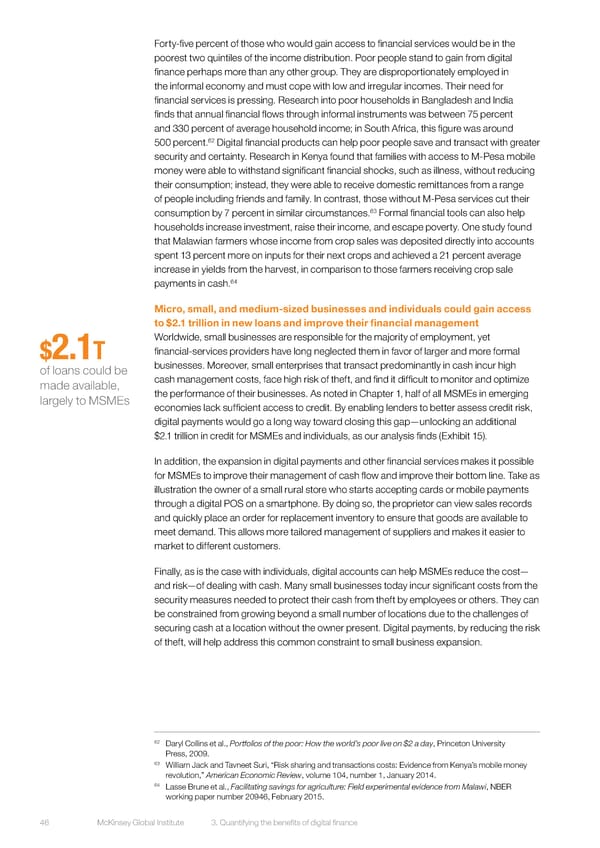Forty-five percent of those who would gain access to financial services would be in the poorest two quintiles of the income distribution. Poor people stand to gain from digital finance perhaps more than any other group. They are disproportionately employed in the informal economy and must cope with low and irregular incomes. Their need for financial services is pressing. Research into poor households in Bangladesh and India finds that annual financial flows through informal instruments was between 75 percent and 330 percent of average household income; in South Africa, this figure was around 62 500 percent. Digital financial products can help poor people save and transact with greater security and certainty. Research in Kenya found that families with access to M-Pesa mobile money were able to withstand significant financial shocks, such as illness, without reducing their consumption; instead, they were able to receive domestic remittances from a range of people including friends and family. In contrast, those without M-Pesa services cut their 63 consumption by 7 percent in similar circumstances. Formal financial tools can also help households increase investment, raise their income, and escape poverty. One study found that Malawian farmers whose income from crop sales was deposited directly into accounts spent 13 percent more on inputs for their next crops and achieved a 21 percent average increase in yields from the harvest, in comparison to those farmers receiving crop sale 64 payments in cash. Micro, small, and medium-sized businesses and individuals could gain access to $2.1 trillion in new loans and improve their financial management Worldwide, small businesses are responsible for the majority of employment, yet $2.1T financial-services providers have long neglected them in favor of larger and more formal of loans could be businesses. Moreover, small enterprises that transact predominantly in cash incur high made available, cash management costs, face high risk of theft, and find it difficult to monitor and optimize largely to MSMEs the performance of their businesses. As noted in Chapter 1, half of all MSMEs in emerging economies lack sufficient access to credit. By enabling lenders to better assess credit risk, digital payments would go a long way toward closing this gap—unlocking an additional $2.1 trillion in credit for MSMEs and individuals, as our analysis finds (Exhibit 15). In addition, the expansion in digital payments and other financial services makes it possible for MSMEs to improve their management of cash flow and improve their bottom line. Take as illustration the owner of a small rural store who starts accepting cards or mobile payments through a digital POS on a smartphone. By doing so, the proprietor can view sales records and quickly place an order for replacement inventory to ensure that goods are available to meet demand. This allows more tailored management of suppliers and makes it easier to market to different customers. Finally, as is the case with individuals, digital accounts can help MSMEs reduce the cost— and risk—of dealing with cash. Many small businesses today incur significant costs from the security measures needed to protect their cash from theft by employees or others. They can be constrained from growing beyond a small number of locations due to the challenges of securing cash at a location without the owner present. Digital payments, by reducing the risk of theft, will help address this common constraint to small business expansion. 62 Daryl Collins et al., Portfolios of the poor: How the world’s poor live on $2 a day, Princeton University Press, 2009. 63 William Jack and Tavneet Suri, “Risk sharing and transactions costs: Evidence from Kenya’s mobile money revolution,” American Economic Review, volume 104, number 1, January 2014. 64 Lasse Brune et al., Facilitating savings for agriculture: Field experimental evidence from Malawi, NBER working paper number 20946, February 2015. 46 McKinsey Global Institute 3. Quantifying the benefits of digital finance
 DIGITAL FINANCE FOR ALL Page 59 Page 61
DIGITAL FINANCE FOR ALL Page 59 Page 61